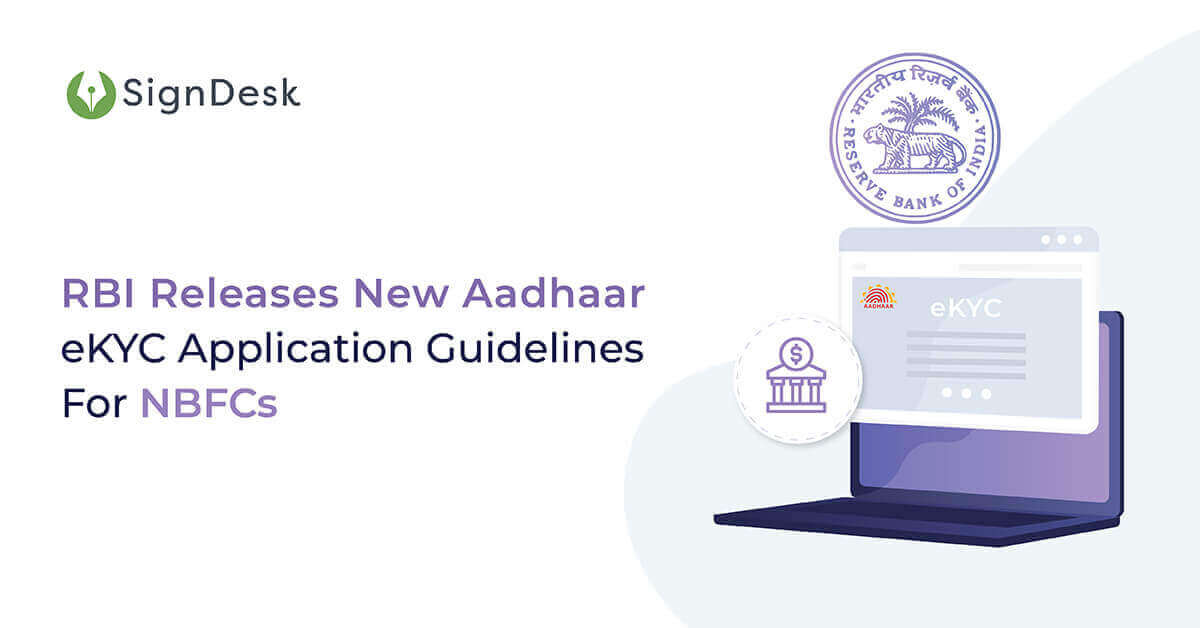New Aadhaar Licence Procedure For NBFCs
In a notification sent on September 13, 2021; RBI informed the chairpersons & CEOs of NBFCs of the new guidelines for applying for an Aadhaar licence to use online eKYC for client authentication via the client’s Aadhaar number.
Under the Prevention of Money Laundering Act (2002), the Central Government can allow non-banking entities to carry out customer authentication via online eKYC, by releasing a notification following consultation with UIDAI and appropriate regulators.
Before this, NBFCs were barred entirely from using the Aadhaar online eKYC facility for client authentication due to a supreme court ruling in 2018 that expressed concerns regarding the risks of online eKYC and put an end to the usage of eKYC for client authentication of any contract.
Subsequently, PMLA (2002) was amended and Section 11A was inserted, which allowed for –
- Banking companies to employ Aadhaar eKYC for authentication
- The central government, in consultation with UIDAI, to permit non-banking companies to use eKYC
Additionally, Section 11A allows the Ministry of Finance to issue notifications permitting non-banking financial companies to use eKYC provided they follow the application steps outlined below.

How can NBFCs start using eKYC?
According to RBI’s notification, NBFCs will have to apply for an Aadhaar authentication licence to utilize the eKYC services provided by UIDAI. This licence can either be a KYC User Agency (KUA) Licence or a sub-KUA Licence.
Both these licences will be issued by UIDAI and entities including NBFCs, payment system providers, and payment system participants desirous of obtaining these licences must submit an Aadhaar Licence application to UIDAI.
The format for this application can be found here. This application can be sent via email to the appropriate regulator, which in this case is the RBI. Specifically, the application must be sent to the Chief General Manager In-Charge of the Department of Regulation at RBI.
After scrutiny and consequent approval from the regulator, the application is forwarded to UIDAI where it will be further examined. Following recommendations from the UIDAI, the central government will grant the applicant permission to perform eKYC and UIDAI will provide the necessary authorizations to conduct eKYC.
These authorizations will be subject to payment of Aadhaar licence fees and compliance with the terms of the Aadhaar Act.
eKYC – What NBFCs need to know
What is eKYC?
eKYC is a digital procedure for customer KYC verification carried out using just the customer’s 12-digit Aadhaar number.
Once a citizen enrolls for the UIDAI’s Aadhaar initiative, their data is collected and stored by UIDAI in a secure database for authentication purposes. This data includes –
- Demographic information – Name, Date of Birth (Verified) or Age (Declared), Gender, Address, Mobile Number (Optional), and Email ID (Optional)
- Biometric information – Ten fingerprints, Iris scan, Facial live picture
Find out all you’ve ever wanted to know about eKYC here.
Types of eKYC
eKYC comes in two flavours – online & offline.
Offline methods for eKYC include:
- Aadhaar XML file, where the customer downloads an Aadhaar XML file containing their identifying information from the UIDAI website and provides it to a verifier.
- QR-code authentication, where the QR-code on the back of a customer’s Aadhaar card is scanned to obtain authenticating information.
Both these methods were available for use by NBFCs, but they’ve got their own drawbacks.
Online methods for eKYC include:
- OTP-based authentication, where the customer simply enters an OTP sent to their Aadhaar-registered mobile number in order to be authenticated.
- Biometric authentication, where a scanner is used to collect the customer’s biometric information which is matched with the information in UIDAI’s database.
NBFCs can employ online eKYC procedures but have to pay a ₹ 20 transaction fee for every eKYC verification performed.
How online eKYC works
RBI’s procedure for performing eKYC is exceedingly simple and takes mere minutes to perform.
Here’s how online eKYC verification goes.
- The customer provides their 12-digit Aadhaar number
- The customer either generates an OTP on their registered mobile number, or biometric scanners are used to scan fingerprints or retina
- The OTP is verified by UIDAI, or scanner readings are verified with original fingerprints & retina scans
- Once verification is complete, UIDAI releases demographic information to the agent or organization performing eKYC. This information can be stored in a remote server for easy access.
The entire procedure is completely digital, paper-free, and doesn’t require the customer to carry any identifying documents, making it seamless and customer-friendly.
What NBFCs can expect from eKYC
eKYC provides numerous advantages to both NBFCs and their customers. Here are the benefits NBFCs can likely experience by switching to eKYC from regular paper-based KYC verification.
- Instant verification
Customers are verified almost instantly. By digitizing KYC verification, eKYC reduces the time taken to verify a customer from 10-20 days to mere minutes.
This has precipitated an enormous reduction in operating costs for businesses, estimated at 90%, and a stark rise in efficiency and time saved.
- Increased security
Biometric technology for KYC verification and data security measures for the Central Identities Data Repository (which houses Aadhaar information) ensures that customer data is safe and deter fraud.
- Zero paper documents
eKYC requires no identifying documents, as all the information required to verify a customer is directly available from the Aadhaar database.
This reduces dependencies on paper-based documentation and has been shown to boost productivity and audit efficiency.
The ease of the eKYC channel also encourages customers to go through with the authentication process and not stop the process mid-way, resulting in 60% fewer KYC drop-offs.
- Market penetration & financial inclusivity
India has over a billion Aadhaar cardholders, and all their information is available in the UIDAI database. With eKYC directly integrated with this database, businesses no longer need to invest large magnitudes of funds to expand their markets.
eKYC allows customers with Aadhaar to be verified instantly with minimal machinery to be put in place on the verifier’s side.
Hence, businesses can use eKYC to expand cost-effectively into new markets and bring more customers into the official financial sector by providing them with the opportunity to easily open accounts & access credit.
SignDesk: Award-winning KYC Verification
SignDesk is a seasoned & award-winning RegTech pioneer providing AI-powered verification and documentation solutions to businesses.
We use real-time document verification techniques, OCR-enabled image data extraction, facial matching & ML-based fraud filters to automate and expedite the KYC verification process.
Our KYC verification solutions have helped our 350+ clients reduce onboarding expenses, cut down on KYC drop-offs, reduce TAT by 99%, and safeguard against fraud using cutting-edge compliance technology.
Our efforts to automate KYC have been recognized in the form of numerous awards, the latest being the Best AI/ML Product at InnTech 2020 and the Global Banking & Finance Review’s Best Digital Onboarding Product of 2020.
Are you ready to join 60+ major banks & NBFCs, and start onboarding with digital KYC? Book a free demo with us now and let’s get started!
